Eero Pro 6E mesh Wi-Fi review: More family sedan than sports car
Expert’s Rating
Pros
- Stable Wi-Fi
- Fastest Eero yet
- Very user friendly
- Small size and inoffensive design
- Eero Secure and Secure+ are a great value
- 2.5GbE ethernet means faster wired internet
- Surprisingly good gaming performance
Cons
- Somewhat limited configuration options
- Only one 2.5GbE ethernet port per device and sub-gigabit Wi-Fi speed
- Somewhat pricey
- HomeKit Secure Router support may have finally gotten the ax
Our Verdict
The Eero Pro 6E three-pack is an excellent mesh system that continues to be reliable and easy to use. It may not keep up with the big dogs in throughput, but it’s still capable and offers better value overall than the prestige mesh systems offered by other companies.
Best Prices Today: Eero Pro 6E
This year’s Computer Electronic Show (CES) came and went, leaving behind a flurry of exciting announcements about the latest Wi-Fi 6E and Wi-Fi 6 network gear. Mesh systems like Netgear’s powerful-yet-too-expensive Orbi 6E system and TP-Link’s XE200 were announced as a throughput arms race continues to blossom, yet there was no announcement from Eero. This makes sense—after all, didn’t the company just release the Eero Pro 6 and Eero 6 routers? Yet here we are, with Eero having announced its next update to its mesh routers all at once on March 23. This included the Eero Pro 6E and the Eero 6+.
Although ostensibly the big news here was that Eero finally has hardware supporting the 6GHz band, I would argue that the more important update to these systems is 160MHz support. This is the means by which wireless speeds can approach or go beyond gigabit. I got a chance to spend some time with the Eero Pro 6E three-pack, and have been running it as my primary mesh system for the last two weeks. From where I sit, this kit continues to provide the kind of generally hassle-free network experience Eero is known for, but buyers should temper their expectations regarding performance, while also noting one very important omission: HomeKit Secure Router support (more on that later).
Eero Pro 6E: What you get
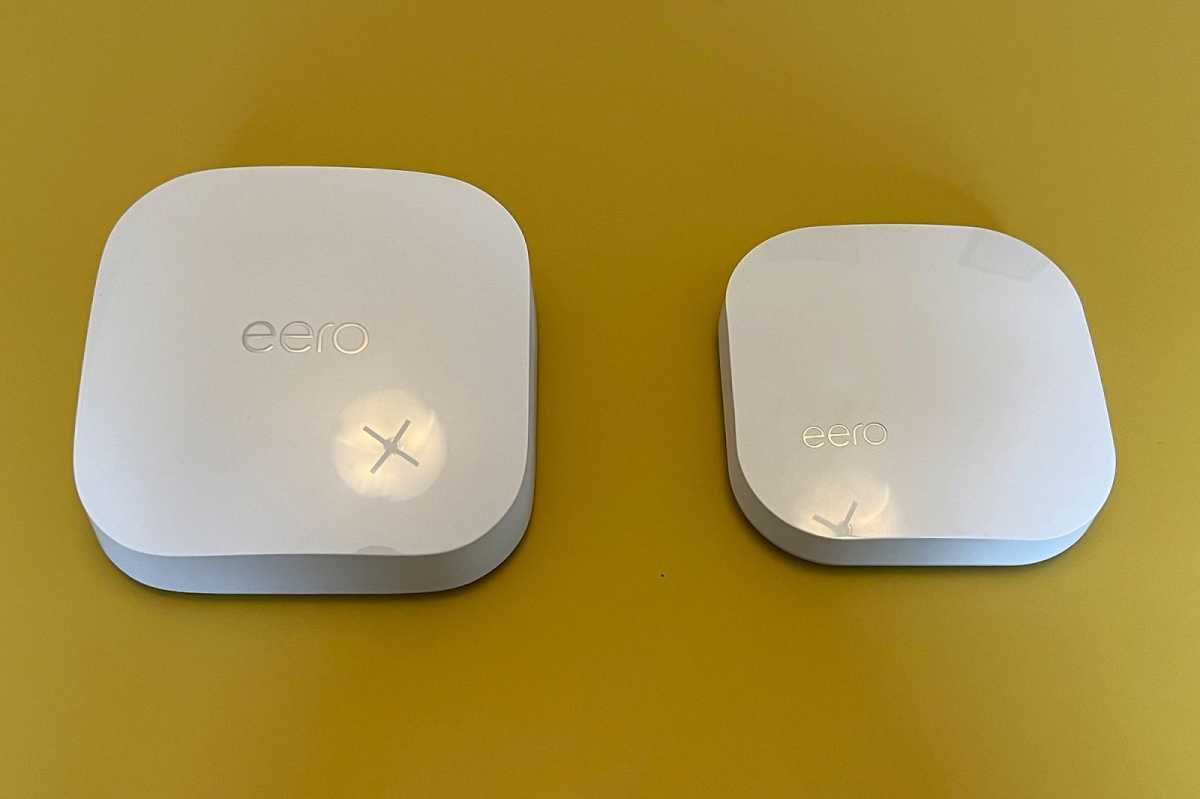
Wes Davis / Foundry
My experience with Eero’s previous Wi-Fi 6 effort is indirect—I reviewed the Ring Alarm Pro for sister publication TechHive, which contains an Eero 6, but I haven’t actually seen an Eero Pro 6 in person. I was surprised, then, when I opened the box for the Eero Pro 6E, which uses the same physical design as the Pro 6, to find that the hardware is a fair amount beefier than the low-profile Eero Pro that I’ve been using for years now in my network. Still, compared to the behemoths that other companies have been releasing, the Eero Pro 6E is a compact, unassuming router.
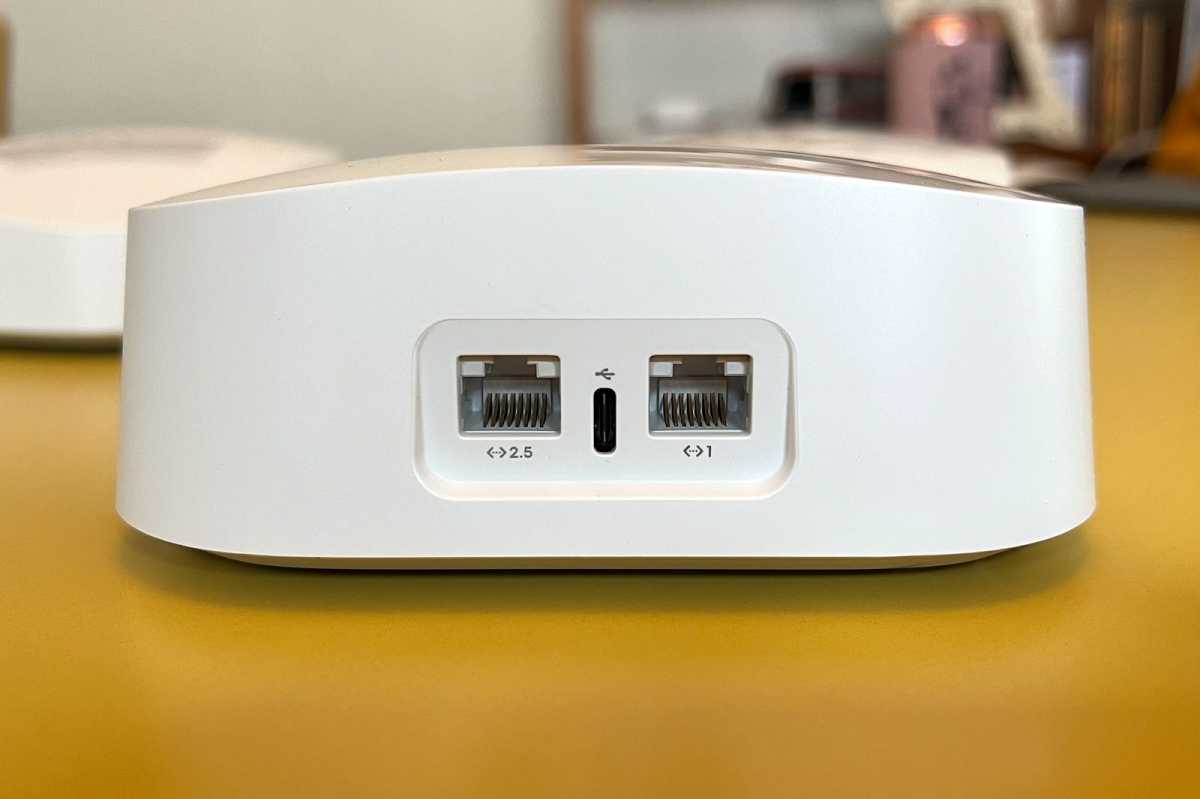
Wes Davis / Foundry
Visually, as an homage to its namesake Eero Saarinen’s architectural style, it’s a tad more subdued, and remains one of the more inoffensive-looking, approachable routers on the market today. Breaking up an otherwise smooth, featureless facade is a single toggle-able status LED, an Eero logo, and two ethernet ports on the back flanking a USB-C power input. There is one sneaky, major upgrade here though: One of the two ethernet ports—either of which can serve as the WAN port, by the way—is a 2.5Gbps port, which is a first for Eero’s hardware. You’d be forgiven for missing it, as it’s labeled with the tiniest letters. If you didn’t read anything about it going in, you’d never know it was there, not least because Eero is like the 1995 Toyota Camry I used to drive—it will reliably get you where you’re going, but it’s not going to break any records doing it.
The Eero Pro 6E is again a tri-band router, but where the previous Eero Pro models featured a second, higher-bandwidth 4×4 MU-MIMO 5GHz band, the 6E features a 2.5GHz, 5GHz, and 6GHz band, all of which are 2×2 MU-MIMO. It’s powered by a leaner 1GHz CPU, too, as opposed to the 1.4GHz CPU of the Eero Pro 6 before it. The Pro 6E still functions as a Zigbee hub and, of course, works with Alexa.
Eero Pro 6E: Performance
If you’re going into the Eero Pro 6E expecting to have the doors blown off, you’ll be sorely disappointed. That’s not to say it’s dog slow—far from it—but when you compare it to the unbelievable throughput offered by the Orbi 6E system, it looks kind of shabby by comparison. But that’s only if you’re looking at benchmarks right next to the router. Like a sleeper car, what it does best isn’t immediately apparent until you look deeper.
I tested the Eero Pro 6E with three primary pieces of equipment: a MacBook Air that was hardwired to the Eero Pro 6E via a Plugable 2.5GbE USB-C ethernet adapter, a 2019 Lenovo Yoga with an AX201 card capable of 160MHz channel bandwidth Wi-Fi 6 connections, and a Samsung Galaxy S21 Ultra that can pull off Wi-Fi 6E with 160MHz channel bandwidth. Rather than perform internet speed tests, I benchmark with TCP transfer tests using the network testing software iPerf 3, which simulates file transfers and reports throughput, and tells much more about the performance of the network than a simple download test. Because of that, I simply don’t bother with internet speed tests at all. I conduct a transfer test six times, then I average the throughput for each tested location.

Brad Chacos/IDG
Wi-Fi 6E performance was okay up close, with the Eero doing a little worse than the Linksys Atlas Max 6E at less than 5 feet away, with a direct line of sight. That number dropped off quickly when I moved away, managing “only” 639Mbps average, compared to 889Mbps on the Linksys and 1.22Gbps on the Netgear Orbi 6E. The story doesn’t improve for Eero on the 6GHz band, with the signal not quite reaching in at least one location where there was significant physical interference—this shouldn’t be a surprise to anyone, as Wi-Fi 6E is by its nature more range-limited and can’t push through substantial barriers as well as even a 5GHz signal. The Netgear and Linksys routers were able to hit this area, albeit with massively reduced throughput.

Brad Chacos/IDG
Things get better with Wi-Fi 6 on the 5GHz band—the Eero Pro 6E system isn’t as fast as the other two systems I use for comparison here, but it nevertheless remained consistent, with speed keeping within a roughly 100Mbps range everywhere it was tested.
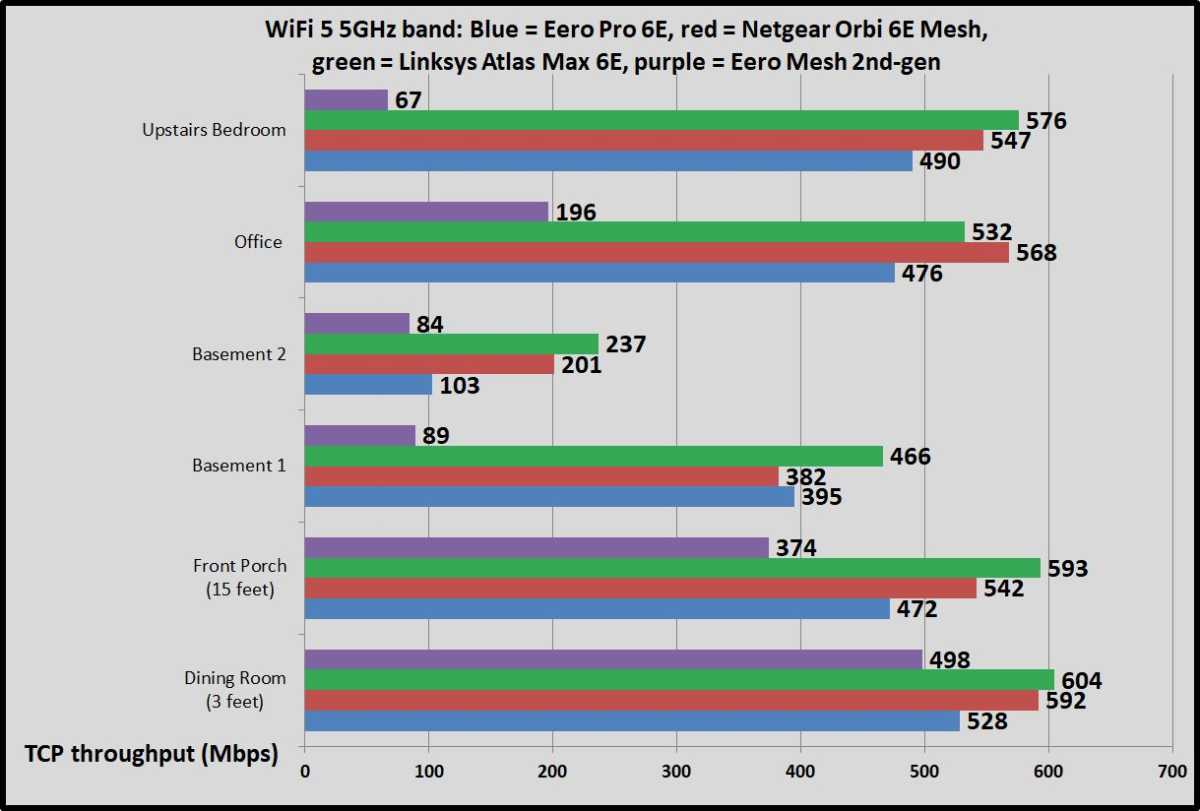
Brad Chacos/IDG
On the Wi-Fi 5 protocol, where most peoples’ devices still live, throughput on the Eero Pro 6E was in the same ballpark as the more expensive systems from Linksys and Netgear—and while it tended to be more than 50Mbps slower, the $699 mesh system costs hundreds less than those routers.
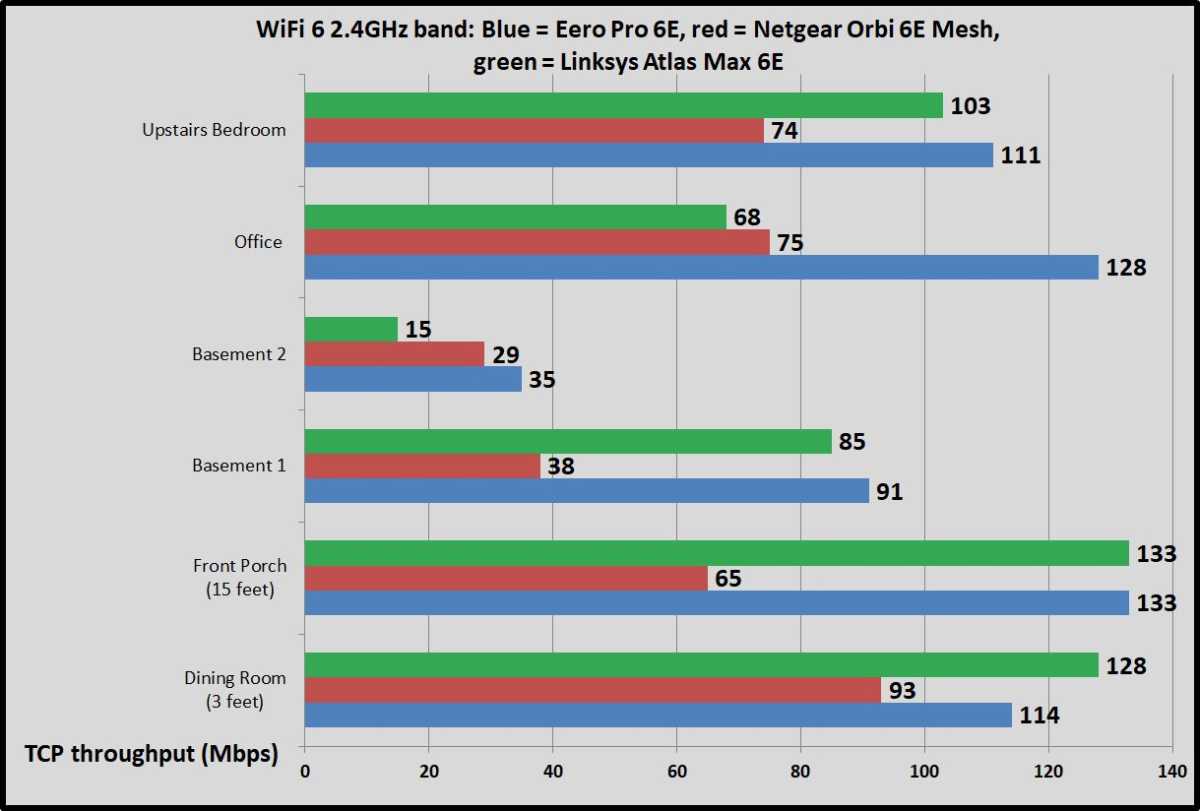
Brad Chacos/IDG
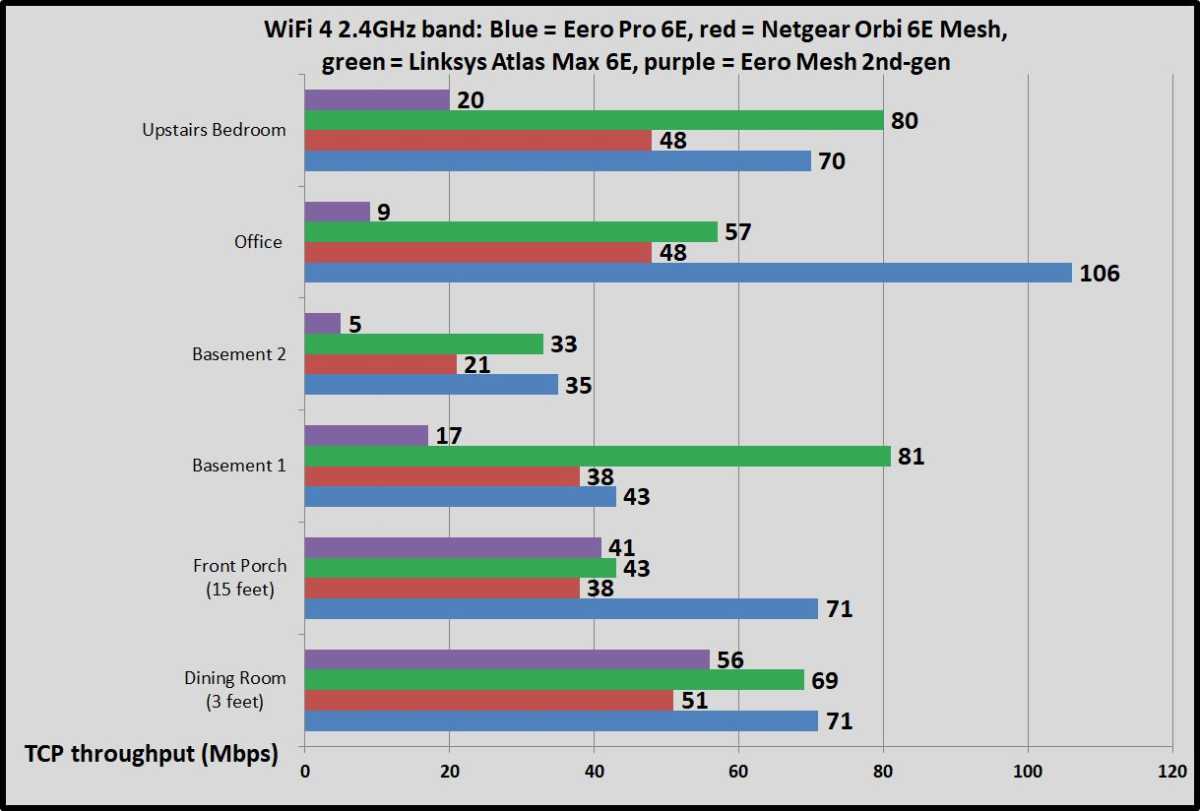
Brad Chacos/IDG
It especially shined on the 2.4GHz band, where it was neck-and-neck with the Linksys Atlas Max 6E when using both Wi-Fi 6 and Wi-Fi 4 (2.4GHz devices don’t generally support the Wi-Fi 5 protocol) standards, and handily outperformed the Netgear Orbi 6E system.
In wireless gaming sessions, where I played Counter Strike: Global Offensive and kept an eye on latency, taking several screenshots at random intervals and averaging the ping—the highest average ping I saw was 38ms, while playing wirelessly in my basement (the peak measurement was 58ms, with a low of 25ms). That’s not to say the experience was flawless, but it was as close as it gets without wires on a non-gaming router—or really, even for most gaming routers.
What does this mean in practical terms? It means in the day-to-day, the Eero Pro 6E mesh system is a stable mesh system that costs a bit more than half what the Linksys system charges for performance that, for most people, will be identical, or perhaps even better, than what Linksys’s system offers. Excellent 2.4GHz performance and low intra-network latency means that when your smart home gear shows poor response times, it’s less likely to be the network’s fault (though much more goes into this than just low latency). In my own experience, with a mostly-HomeKit-based smart home system, I saw excellent performance, even with the most troublesome pieces of equipment in my network.
Eero Pro 6E: So long, HomeKit?
The Eero Pro 6E feature set is unchanged from past Eero systems, but for one key omission: There is no current plan to support Apple HomeKit. When the Eero 6 update happened in early 2021, those routers were likewise released without HomeKit support, with the company telling reviewers and customers alike they were simply awaiting Apple’s certification to move ahead with support. That could be the case again here, but tellingly, Eero’s website explicitly states not only that there are no plans to support the feature, but that the company feels it best to focus engineering efforts on speed and performance. Eero was unwilling to elaborate on this when asked, which doesn’t bode well for fans of Apple’s HomeKit Secure Router feature.
Eero Pro 6E: Other features
Otherwise, like previous Eero systems, users will find in the Eero app what is probably the most well-designed and intuitive router interface on the market today, with some advanced configuration possible for port forward rules, UPnP toggling, and the option to use a custom primary and secondary DNS, should you prefer to point your network at Google or Cloudflare, rather than Eero’s preferred DNS—although this comes at the expense of Eero Secure and Secure+ features. It’s robust for a router smartphone app, towing a nice middle line between being so technical it might drive away more novice users and being so basic that it offers no real control. Eero still offers no web interface for regular customers, and anyone looking for fine-grained control of things like transmission power or toggles for advanced features like OFDMA will need to look elsewhere. Past Eero routers offered no ability to split SSIDs between the 2.4GHz and 5GHz bands, and that remains as true as ever with the new 6GHz variant—you’ll have to rely on the negotiation between your device and the Eero router choosing the proper connection type. As before, Eero offers WPA3 security—the new security protocol that, in a nutshell, promises to fix bad passwords by essentially never actually exchanging those passwords during authentication handshakes.
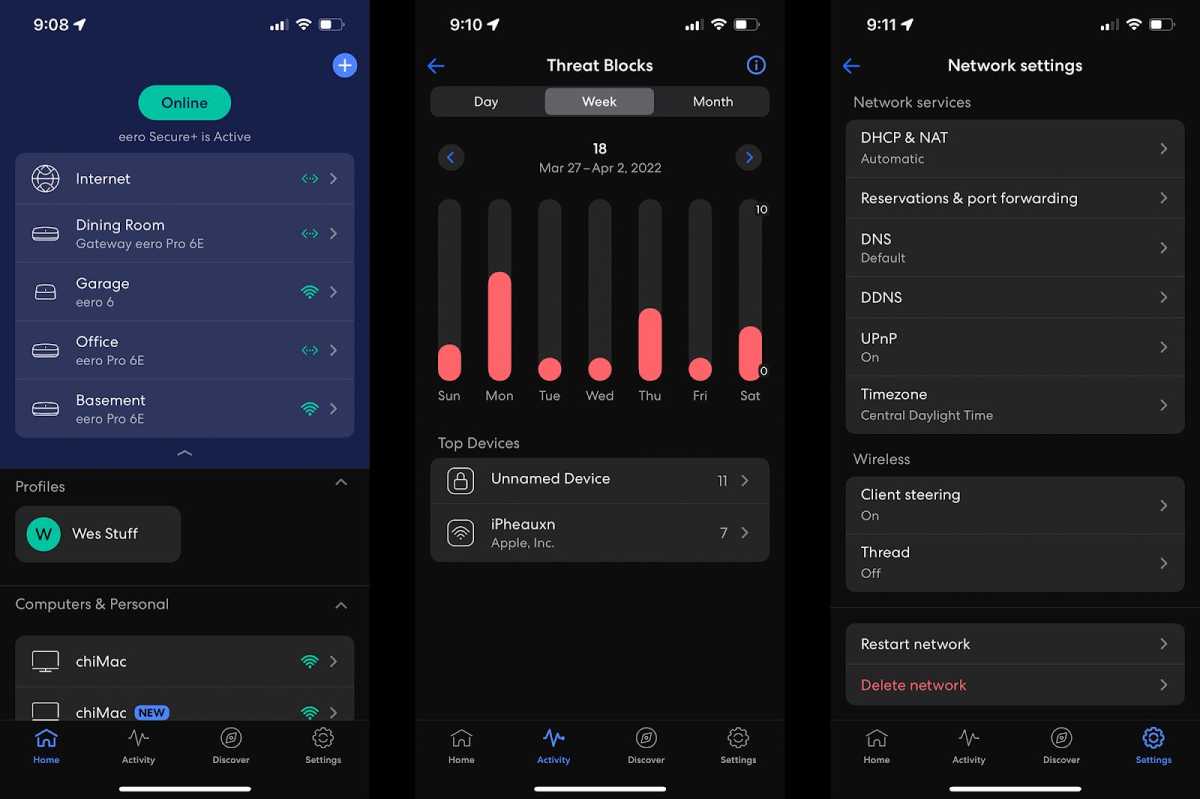
Wes Davis / Foundry
Eero’s security and parental controls suite—the aforementioned Eero Secure—is, of course, available here. For $30 a year, Eero provides network ad- and malware-blocking, along with the ability to view which devices used how much data over the previous day, week, and month. Eero also provides parental controls in the form of basic profile-based content filters. Users can choose pre-made web and app filters for various age groups and leave it at that, or they can augment these settings by going to the Block & Allow Sites section to customize filtering to their liking. Anyone who wants to go further may sign up for the $100/year Secure+, which offers all of that, as well as malware protection from Malwarebytes for up to three devices, Encrypt.me VPN service for five devices, and access to the 1password family plan. Overall, the plans feel worth it, if you like these kinds of services—users should note, however, that Encrypt.me engages in logging users’ information, and the company is open about not offering privacy to users who hope to use its service to circumnavigate copyright infringement laws. It doesn’t look like any of what the company is doing is particularly alarming, but potential users will want to be aware of Encrypt.me’s policies before diving in.
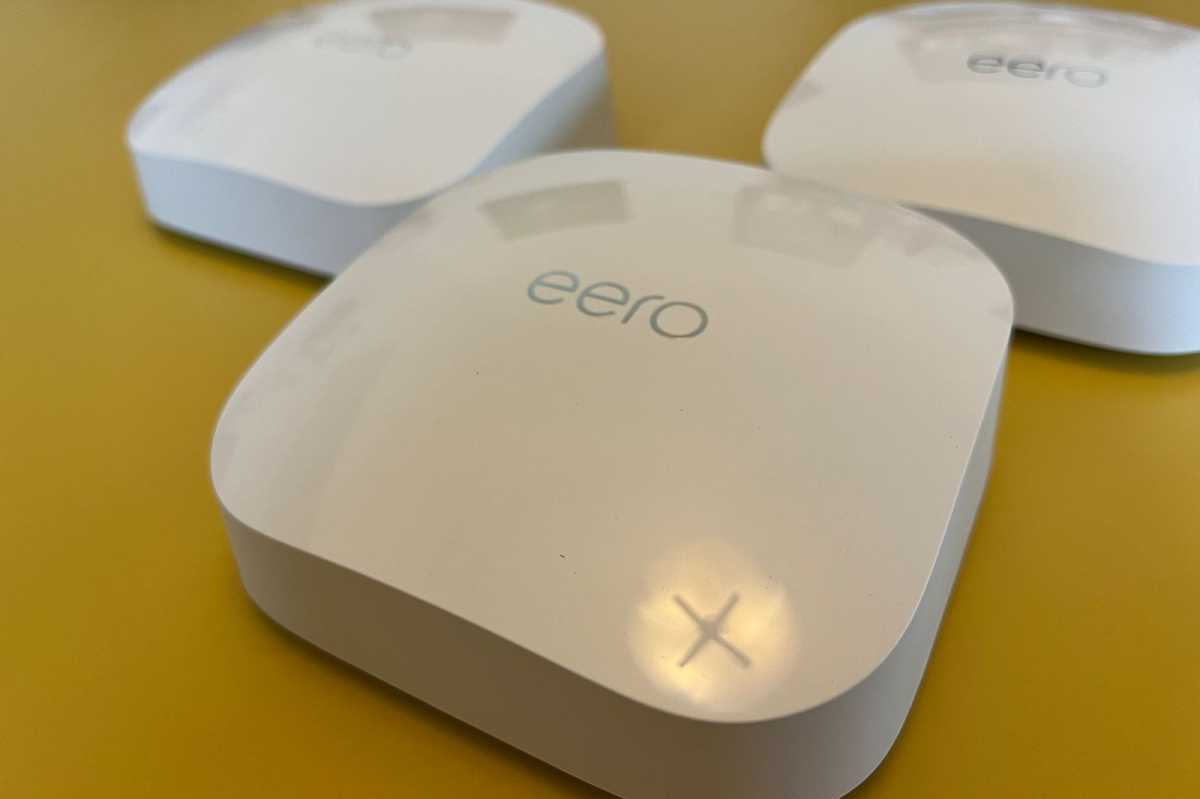
Wes Davis / Foundry
Eero Pro 6E: Final thoughts
Eero’s newest mesh routers are every bit the reliable network gear they ever were. The addition of only one 2.5Gbps port is a tired misstep that many router companies make, given that users won’t likely see that speed, either wirelessly or wired, at their client devices. For anyone already using an Eero Pro 6 system, the benefit conferred by a 160MHz connection may not be worth the extra cost, particularly if any of their client devices support 4×4 MIMO, which is offered by the Eero Pro 6, but not the Eero Pro 6E.
At the end of the day, however, the Eero Pro 6E’s strengths are in its ability to feel like it doesn’t exist. Often, when I’m reviewing a router, I find myself constantly futzing with it for at least a few days while I iron out kinks, but this system worked without issue for the entire time I had it. Although, to be fair, I did replace my existing Eero network with these devices—a very straightforward process, for the record—so my system configuration was preserved. Even so, video and music streaming, online games, and my smart home devices worked perfectly, or at least, as perfectly as they ever do. It was a clear improvement over my aging Wi-Fi 5-based Eero system in terms of responsiveness over the local network, but I have a feeling it’s not a massive leap over the Eero Pro 6, if at all (again, I have not tested the Eero Pro 6).
The Eero Pro 6E three-pack is an excellent mesh system that continues to be reliable and easy to use. It may not keep up with the big dogs in throughput, but it’s a lot cheaper, and that combined with trouble-free day-to-day use makes it a better value than the prestige mesh systems offered by other companies. So at $699, would I run out and buy one right now? Of course not. But I bet if I did, I wouldn’t regret it.
For all the latest Technology News Click Here
For the latest news and updates, follow us on Google News.

